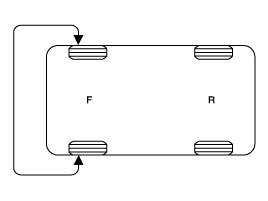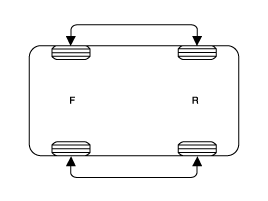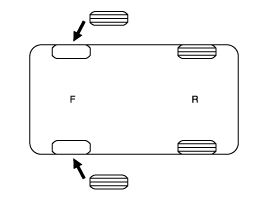 Hyundai Equus: Tire Repair procedures
Second generation VI (2009–2025) / Hyundai Equus VI 2009-2025 Service Manual / Suspension System / Tires/Wheels / Tire Repair procedures
Hyundai Equus: Tire Repair procedures
Second generation VI (2009–2025) / Hyundai Equus VI 2009-2025 Service Manual / Suspension System / Tires/Wheels / Tire Repair procedures
Second generation VI (2009–2025) / Hyundai Equus VI 2009-2025 Service Manual / Suspension System / Tires/Wheels / Tire Repair procedures
| Tire Wear |
| 1. |
Measure the tread depth of the tires.
|
| 2. |
If the remaining tread (A) depth is less than the limit, replace the tire.
|

| Tire Rotation |
Checking For Pull And Wander
If the steering pulls to one side, rotate the tires according to the following wheel rotation procedure.
| 1. |
Rotate the front right and front left tires, and perform a road test in order to confirm vehicle stability.
|
| 2. |
If the steering pulls to the opposite side, rotate the front and rear tires, and perform a road test again.
|
| 3. |
If the steering continues to pull to one side, rotate the front right and left tires again, and perform a road test.
|
| 4. |
If the steering continues to pull to the opposite side, replace the front wheels with new ones.
|
 Alignment Repair procedures
Alignment Repair procedures
Wheel Alignment
When using commercially available computerized four wheel
alignment equipment (caster, camber, toe) to inspect the front wheel
alignment, always position the car on a level surf ...
See also:
Intake Actuator Repair procedures
Inspection
1.
Turn the ignition switch OFF.
2.
Disconnect the intake actuator connector.
3.
Verify that the intake actuator operates to the fresh position when connecting 12V to terminal 3 ...
Heater Control Unit Repair procedures
Replacement
1.
Disconnect the negative (-) battery terminal.
2.
Remove the cowl side trim.
(Refer to Body - "Cowl Side Trim")
3.
To remove the crash pad under cover [RH] (A), press both ...
Rear Seat Cushion Cover Repair procedures
Replacement
[LH]
•
Put on gloves to protect your hands.
•
When prying with a flat-tip screwdriver, wrap it with
protective tape, and ...
Categories
Hyundai Equus Manuals
© 2011-2025 Copyright www.heqmanual.com






